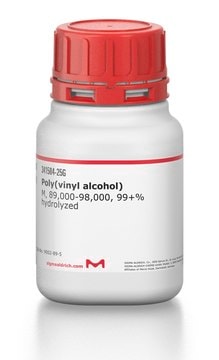Products may be shipped at a different temperature than the recommended long-term storage temperature. If the product quality is sensitive to short-term exposure to conditions other than the recommended long-term storage, it will be shipped on wet or dry-ice. If the product quality is NOT affected by short-term exposure to conditions other than the recommended long-term storage, it will be shipped at ambient temperature. As shipping routes are configured for minimum transit times, shipping at ambient temperature helps control shipping costs for our customers. For more information, please refer to the Storage and Transport Conditions document: https://www.sigmaaldrich.com/deepweb/assets/sigmaaldrich/marketing/global/documents/316/622/storage-transport-conditions-mk.pdf
440744
Polycaprolactone
average Mn 80,000
Synonym(s):
2-Oxepanone homopolymer, 6-Caprolactone polymer
About This Item
Recommended Products
form
pellets (~3 mm)
Quality Level
mol wt
average Mn 80,000
impurities
<0.5% water
mp
60 °C (lit.)
density
1.145 g/mL at 25 °C
Mw/Mn
<2
application(s)
3D bioprinting
advanced drug delivery
SMILES string
C1CCC(=O)OCC1 (Canonical-SMILES)
InChI
1S/C6H10O2/c7-6-4-2-1-3-5-8-6/h1-5H2
InChI key
PAPBSGBWRJIAAV-UHFFFAOYSA-N
Looking for similar products? Visit Product Comparison Guide
General description
- It degrades slower than other biodegradable polyesters in physiological condition, this property can be exploited in the controlled release of drugs in target tissues over a period of time.
- Its poor surface wetting and interaction with biological fluids on account of its hydrophobicity leads to poor cell adhesion and proliferation, hence it is blended with other synthetic /natural polymers.[1]
Application
- PCL loaded with antibiotics may be used to treat infections of the respiratory tract, like tuberculosis.
- Investigations were carried out based upon phenotypic responses of human bone marrow mesenchymal cells (hBMSCs) for different ratio of chitosan/ polycaprolactone (PCL) blends.[1]
- PCL/biomedical ceramic materials have been studied for possible osteo tissue regeneration.
- Action of PCL/graded insulin/beta-5 glycerophosphate concentrations on osteochondral tissue formation through adipose-derived stromal cell differentiation.[2]
- Other general uses include:extrusion aid, die lubricant, mold release, pigment and filler dispersion aid and polyester segments in urethanes and block polyesters.
Features and Benefits
Non-toxic, biodegradable in soil, broad miscibility, mechanical compatibility with many polymers and good adhesion to a broad spectrum of substrates.
related product
Storage Class Code
11 - Combustible Solids
WGK
WGK 3
Flash Point(F)
Not applicable
Flash Point(C)
Not applicable
Personal Protective Equipment
Choose from one of the most recent versions:
Certificates of Analysis (COA)
Don't see the Right Version?
If you require a particular version, you can look up a specific certificate by the Lot or Batch number.
Already Own This Product?
Find documentation for the products that you have recently purchased in the Document Library.
Customers Also Viewed
-
How is shipping temperature determined? And how is it related to the product storage temperature?
1 answer-
Helpful?
-
-
How can I determine the shelf life / expiration / retest date of this product?
1 answer-
If this product has an expiration or retest date, it will be shown on the Certificate of Analysis (COA, CofA). If there is no retest or expiration date listed on the product's COA, we do not have suitable stability data to determine a shelf life. For these products, the only date on the COA will be the release date; a retest, expiration, or use-by-date will not be displayed.
For all products, we recommend handling per defined conditions as printed in our product literature and website product descriptions. We recommend that products should be routinely inspected by customers to ensure they perform as expected.
For products without retest or expiration dates, our standard warranty of 1 year from the date of shipment is applicable.
For more information, please refer to the Product Dating Information document: https://www.sigmaaldrich.com/deepweb/assets/sigmaaldrich/marketing/global/documents/449/386/product-dating-information-mk.pdfHelpful?
-
-
Could you please provide the processing parameters for product 440744?
1 answer-
The production process is proprietary. However, the product is a homopolymer of ε-caprolactone with a concentration of ester bond at 610 - 615 M. It has a hydroxyl end group and a melting range of 58 - 60 °C.
Helpful?
-
-
I would like to know the standard curve of UV-vis absorbance of polycaprolactone.
1 answer-
This product is not tested for data for UV-Vis absorbance, but one source shows it here: https://www.researchgate.net/figure/A-UV-vis-spectra-of-polycaprolactone-PCL-and-aminolysed-PCL-samples-Right-panel_fig4_319107535
Please note, the curve cannot be guaranteed as this is not something that is tested internally.
Helpful?
-
-
What are the processing parameters for the product?
1 answer-
The production process is considered proprietary, however the following details may be shared: The product is a homopolymer of ε-caprolactone The concentration of ester bond is 610 - 615 M. The product has a hydroxyl end group. The melting range is 58 - 60 °C.
Helpful?
-
Active Filters
Our team of scientists has experience in all areas of research including Life Science, Material Science, Chemical Synthesis, Chromatography, Analytical and many others.
Contact Technical Service

![2,3,6,7-Tetrahydro-8-hydroxy-1H,5H-benzo[ij]quinolizine-9-carboxaldehyde 98%](/deepweb/assets/sigmaaldrich/product/structures/166/830/a0d9a84a-5623-41a1-a54b-3b0272e5b28c/640/a0d9a84a-5623-41a1-a54b-3b0272e5b28c.png)






